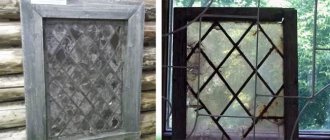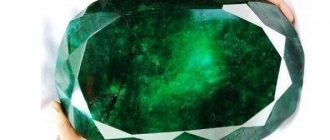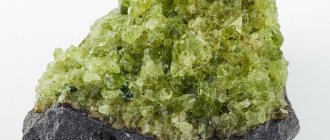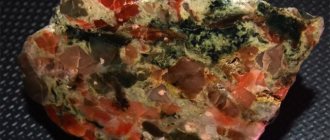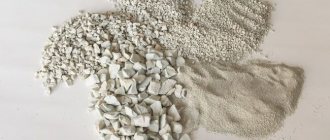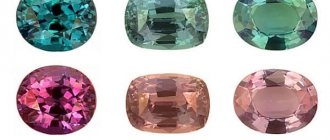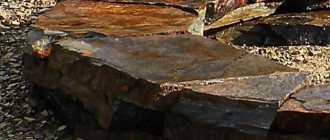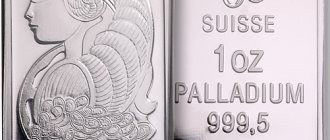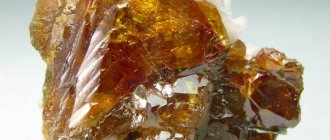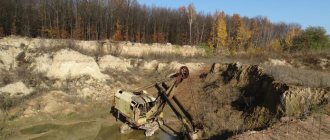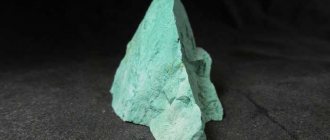Kaolin in paints and varnishes
Review of publication materials.
Compiled by Yu. K. Pirogov Kaolin is the common name for a mineral product consisting entirely or partially of kaolinite aluminosilicate. Ground and graded grades of kaolin may contain small amounts of related lamellar silicates (mica, illite, chlorite, smectite) and quartz. Most kaolins used in the paint industry are washed to remove these mineral impurities. Kaolin has a flat structure, but, unlike talc and mica, its role in coatings is determined by its contribution to the optical rather than the physical properties of the coatings.
The structure of kaolinite can be described as a layer of silicon rings connected to a layer of aluminum octahedra via oxygen atoms, as shown in Figure 1.
Well-formed kaolinite particles have the appearance of hexagonal plates. In nature, these plates are stacked into “stacks” or “books”. Because an individual kaolinite particle has an oxygen-containing surface on one side and a hydroxyl surface on the other, it is tightly bonded to the particles above and below it. This makes splitting the layers a more difficult process than for other flat silicate fillers - talc and mica. Hydrophilic kaolin is therefore easily dispersed in water; For non-aqueous applications, matrix compatibility is improved by surface treatment.
Brands of kaolin
Kaolin clays are usually divided into hard and soft, according to terminology coming from the rubber industry. Hard clays are relatively poorly crystallized, very fine-grained kaolins with a sedimentation median diameter of approximately 0.2-0.4 μm. They provide reinforcing properties in rubbers, giving hard, unvulcanized compounds. Soft clays are better crystallized, coarse kaolins, with particles approximately 1.3 microns in diameter. They have less of a reinforcing effect, producing softer mixtures.
Paint and varnish grades of kaolins are divided into conventional (hydrated, air-fractionated) and calcined. Conventional kaolins are structurally unmodified and retain their hydrophilic surface hydroxyls, i.e. water of crystallization. Most conventional kaolins used in coatings in the US and Europe are washed. These grades are obtained by dispersing clay in water, followed by centrifugation or hydrocyclonation to remove impurities and obtain the required particle size distribution. The purified suspension is either dewatered (to remove water-soluble impurities) and dried, or concentrated to 60-85% dry matter and supplied as a suspension or granules. Washed stamps are often treated to improve their whiteness. Treatment includes chemical bleaching and/or high-intensity magnetic separation to remove iron, titanium and other coloring impurities.
Delaminated kaolin is obtained by grinding coarse fractions obtained by washing soft clays. At the same time, kaolinite stacks are stratified into thin, wide individual plates, improving brightness, light-scattering and barrier properties.
Dry-ground grades of kaolin are separated in the air flow to reduce the amount of impurities and obtain the desired size distribution. The paint industry uses only small amounts of dry-ground kaolin due to its poor color performance and higher abrasiveness due to impurities.
Calcined kaolin is obtained by heat treatment of washed and bleached kaolin. Low temperature calcination, at approximately 650-700°C, removes structural hydroxyls and produces amorphous metakaolin. The specific gravity drops during the process from 2.58 to 2.50, while hardness and porosity, and therefore brightness, light scattering and oil absorption, increase. Fully calcined clays with maximum brightness and light scattering are obtained when heated to 1000-1150°C. This is a sufficient temperature for complete destruction of the amorphous structure with a subsequent increase in specific gravity to 2.6-2.7, but without mineralogical transformation into mullite (specific gravity 2.6-2.7, hardness 6-7). The balance of light scattering and brightness can be changed by temperature, heating rate and fluxes used in the calcination process.
Due to the significant influence of kaolin on the optical properties of coatings, calcined kaolins are offered in a larger range than other silicate functional fillers to provide a full range of crystallinity and structure, particle sizes, brightness and color shades, hiding power and matting properties. Kaolins can be even more diverse when chemically modified. There are grades coated with dispersants for ease of dispersion in water, as well as those treated with silanes or stearates for improved compatibility with organic matrices.
Where is the mineral mined?
The places where kaolin is mined are determined by the characteristics of its formation.
- Primary, sedimentary white clay, formed as a result of weathering and decomposition of rocks, is found at a depth of 5 to 50 meters. Externally, kaolin deposits resemble nests or curls. The minimum thickness of such clay accumulation can be 2 meters, the maximum - 120.
- Secondary type kaolin (redeposited) is obtained as a result of erosion and subsequent deposition of rocks. Layers of clay are found in sand. The thickness of such deposits is about 20 meters, but no more than 20% of them can be used (that is, it is permissible to take secondary mineral from a depth of maximum 4 meters).
Geologists currently estimate global reserves of kaolin at 15–16 billion tons. Deposits up to 5 million tons are considered small, over 30 - large. Deposits of white clay are found in the following areas:
- Europe - in Bulgaria, Hungary, Great Britain, Poland, Russia, Germany, Ukraine, Spain, Finland, Portugal, Czech Republic;
- Asia - in China, Uzbekistan;
- both American continents - Brazil, USA;
- Africa - in Angola, Kenya.
Since kaolin is a clay, it is found in the upper layers of the earth's crust. This location determines the optimal mining method - open pit.
Properties and uses of kaolin
The USA is the main supplier of kaolin paint grades, currently producing about 7.5 million tons/year, 45% of which is exported. Domestic kaolin consumption consists of approximately 64% washed, 15% delaminated, 11% calcined and 9% dry ground. About 66% of domestic consumption is used in the production of coating (56%) and filling (10%) paper; the next consumer is the paint and varnish industry with 6%.
Russia consumed (in 2003-2004), according to estimates, 330-400 thousand tons of kaolins, including 35-40 thousand tons in the paper industry, 250-300 thousand tons in the ceramic, refractory, and cement industries ., in rubber production 40-50 thousand tons, paint and varnish industry - less than 1 thousand tons. 1-1.5 thousand tons are exported. clay for ceramics and dry ground kaolin for rubber goods. 170-180 thousand tons of kaolin are imported:
- from Ukraine 150-160 thousand tons (90-93%), including 120-140 thousand tons of kaolin clay for ceramics, refractories and cement, 2-3 thousand tons of dry ground kaolin and more than 20 thousand tons - hydrocyclonated kaolin for filling and coating of papers;
- from Spain 0.6-1 thousand tons (for ceramics);
- calcined and delaminated kaolin is imported from Germany, England and Finland (re-export/USA) 14-15 thousand tons, mainly for enterprises with foreign participation - paper (98-99%) and paint and varnish (up to 1%) industries.
The range of properties of various grades of kaolins is presented in Table 1.
Kaolin is mainly used in paint formulations as an extender (distributor) of titanium dioxide in water-based architectural paints. This is where calcined kaolins typically realize their outstanding properties - brightness, titanium dioxide distribution and hiding properties. Washed and delaminated kaolin also partially improves the distribution of titanium dioxide, slightly increases hiding power and can be used to control gloss (the smaller the particle size, the higher the gloss).
Despite the fact that the paint and varnish industry is mainly interested in the optical properties of kaolins, this mineral also serves as a functional filler. Kaolin is a finely dispersed, layered, chemically inert material. It has a neutral or slightly acidic pH 10% aqueous dispersion and can be supplied with a specified particle size distribution. Kaolins are used to improve thixotropic properties, flow, leveling properties, film smoothness, film strength and weather resistance. Delaminated kaolins are preferred for improving barrier properties, reducing fading and overall durability of exterior coatings. Calcined kaolins, due to their increased hardness, also increase the wear resistance of coatings. The types of coatings in which kaolins are used are listed in Table 2.
Excellent sorbent
Once in the body, kaolin clay acts as a sorbent. It perfectly absorbs all the toxins and poisons in it. It absorbs and neutralizes waste products of cells and harmful bacteria, and then removes them from the body. Clay also effectively copes with radiation, toxic gases, heavy metals and slags.
Macaw parrots learned about its wonderful properties and have been using it for many generations. Animals eat poisonous berries that no one else dares to eat. But they don't die. They snack on dangerous fruits with kaolin, which neutralizes the poison and gives the parrots a powerful competitive advantage in the fight for food.
People have also known for a long time about the healing qualities of clay. In Rus' it was used as an antiseptic; the peoples of the Far East added it to soups and broths, and to animal milk. It was eaten by the peoples of Africa, Latin America and the Middle East. Many people still use it in folk medicine to prevent diseases, and also as a remedy for radiation sickness, parasites and poisoning.
Paints with high volume concentration of pigments
Paints with high pigment volume concentration (PVC), exceeding the critical pigment volume concentration (CPV), are economical and usually have high hiding power at low and very low TiO2 concentrations. Covering power is a decisive property of high-OCP paints; it is regulated by both the TiO2 concentration and the packaging of the extender-filler. At a given TiO2 concentration, the filler-air contact area in the extender-filler package is the main regulator of covering power in dry paint films. Extenders with a porous structure, such as calcined kaolin, provide a high filler-air contact area and, consequently, high covering power of paint and varnish coatings.
Paints with OCP below critical, such as gloss and semi-gloss paints, do not have a gas phase in dry films. Here, the entire surface of the solid particles is moistened with a binder, forming a smooth film of the lacquer coating, and the covering ability is determined mainly by TiO2 particles and only to a lesser extent by the closed air microcavities of kaolin particles. At any concentration of TiO2, covering power improves when maximum exposure of the surface of TiO2 particles to light is achieved.
Using finely dispersed kaolin with particle sizes of the order of 0.2-0.4 microns (similar to the sizes of TiO2 particles), we obtain an optimal volumetric distribution of TiO2 particles, preventing further agglomeration and ensuring maximum exposure to light.
The choice of extender is directly related to the main properties that require improvement or regulation when creating a paint formulation.
When filled above KOKP, the paints will be matte. The degree of haze is determined by the reflection of light at 85 degrees, called gloss. Paints filled below KOKP have a gloss and can be semi-matte or high-gloss. Gloss is measured at light reflection angles of 60 or 20 degrees. Consider using suitable kaolin extenders in matte, low-gloss paints. The goal is to improve hiding properties while maintaining or improving other properties.
To achieve low gloss, systems with high OCP use extender fillers with large particles, which adversely affect covering properties.
To avoid a decrease in hiding properties with low gloss, finely dispersed high-white calcined kaolins have been developed, for example KAOKAL®, MIKAO® 03-98, MIKAO® 02-98. The structured surface of calcined kaolin particles effectively scatters light, resulting in a reduction in gloss. In addition to low gloss and high hiding power, this surface structure shows excellent finishing properties (minimal differences in gloss with different paint layer thicknesses).
The finely dispersed (1-3 microns by laser diffraction) extender gives good distribution of TiO2, leading to improved hiding power. The unique surface structure effectively diffuses light, producing low gloss. Comparative characteristics of calcined kaolins of different brands, as well as improved enriched kaolin KVF-90-1 are given in Table 3.
With the increasing demand for purer shades and high whiteness of paints, new calcined kaolins with high brightness have been developed. These grades, with brightness levels greater than 95%, produce bluish or neutral tones and excellent hiding power that can be achieved at a reasonable cost.
Along with winning shades, high-brightness products have smaller particle sizes, increased porosity, but also increased oil absorption compared to conventional brands. As a result, when replacing conventional brands in a one-to-one ratio, the hiding power increases significantly and the gloss improves. Increasing the hiding power of the filler makes it possible to reduce the TiO2 content. Although TiO2 replacement rates of up to 30% are possible, this is not usually used in practice due to limitations imposed by the poor hiding power of wet LC films. In other words, replacing a large proportion of TiO2 leads to a large difference in the covering properties of dried and non-dried paint films. At the same time, replacing 10-15% TiO2 does not provide such a noticeable difference in the covering properties of dried and non-dried paint films. The amount of fine extender required to achieve 10-15 percent TiO2 savings is typically significantly lower than conventional kaolin extender. The difference in pigment volume is then removed by adding coarser fillers, which in turn will reduce the gloss to its original value. It is important to understand that having the increased hiding power of calcined kaolins, we have more latitude in the selection of the formulation (i.e. we can reduce the amount of TiO2, the amount of fine extender, and we can use coarser, cheaper fillers, compared to using conventional brands of extenders). Increasing the concentration of coarse filler will, in turn, increase the wear resistance of the coating. Lower TiO2 content with less fine extender will provide cost benefits with this formulation approach.
Chemical composition of koalin
The main component of the chemical composition is kaolinite, a mineral from the group of hydrous aluminosilicates. Thanks to it, kaolin is light-colored, mostly white, with a slight yellowish, bluish or greenish tint - this depends on the presence and amount of impurities: copper, zinc, iron and others.
The composition also contains microelements that bring considerable benefits to the human body:
- silica (silicon dioxide) - increases immunity, stimulates metabolic processes, strengthens blood vessels, has a beneficial effect on skin elasticity;
- magnesium - normalizes the excitability of the nervous system and muscle tone, strengthens bones, activates protein compounds important for growth and normal functioning;
- calcium - participates in hematopoiesis, strengthens muscles and bones;
- iron - improves the supply of oxygen to the body's cells;
- phosphorus - has a positive effect on the functioning of the nervous system, brain and bone marrow.
It is important that kaolin contains beneficial microelements in easily digestible forms.
References
- Fillers for polymer composite materials / Ed. Katz G.S. and Milewski D.W. M.: Chemistry. 1981.
- Broom, TT Origins of Certain Kaolin Pigments and Their Relative Performance in Flat Wall Paints. Mod. Pt. and Ctgs. Jan 1997.
- Ashek, L. New Generation Kaolin-based Pigment Extenders. PCI, March 2003.
- Irvine, E. No Compromise: The Effectiveness of Specialty Ultrafine Kaolin Pigments as TiO2 Augmenters. Mod. Pt. and Ctgs. Jan. 2001.
- Stoneback, C. Using Kaolin as a High Performance Coating Additive. PCI, October 1996.
- Cuillo, P. A., Robinson, S. Kaolin Clay: Functional Optical Additives. PCI, Aug 2003.
- Bykov E.A. Silicate fillers are an important component of high-quality paints and varnishes: Paints and varnishes and their application. 1-2/2005
Type of substance
Additive E 559 belongs to the group of emulsifiers.
Included in SanPiN 2.3.2.1293-03 as a product that prevents caking and clumping. The forming substance is the mineral kaolinite , which is an aluminum salt of silicic acid.
Aluminosilicate is obtained by open-pit mining followed by multi-level purification from impurities (enrichment) by gravity in centrifuges. Enriched kaolin is dehydrated and dried in industrial ovens.
The quality of the E 559 additive is determined by whiteness, chemical composition, and dispersity.
Main manufacturers
The largest Russian supplier of aluminosilicate is the Novokaolin Mining and Processing Plant (Chelyabinsk region).
The company was founded in 1941. The raw materials were used to make rubber rollers for tanks. Leading global manufacturers:
- Bassermann minerals GmbH & Co.KG (Germany);
- Pubai kaolin co., ltd (China);
- LOBECK CHEMIE AG (Switzerland);
- SEDLECKY KAOLIN, as (Czech Republic).
Traditional healers use kaolin to treat cancer. Official medicine does not use the supplement as an oncoprotector, but recognizes the benefits of the substance during the recovery stage after chemotherapy and radiotherapy.
White clay face mask
The delicate consistency of kaolin is an ideal solution for sensitive skin. This substance softens and has a mild exfoliating effect. White clay masks help relieve redness, eliminate irritation, and prevent the appearance of acne. There are several recipes with different types of action:
- rejuvenating;
- for problem skin;
- against acne;
- whitening
For acne
Acne is a problem for teenagers, but people of any age can suffer from unpleasant breakouts from time to time. To restore radiance and purity to your face, you can use the following recipe from white mineral:
- Pour boiling water over several sprigs of fresh thyme (or 1 tbsp dry).
- Cover with a lid and leave until cool.
- Mix the broth with white kaolin until it reaches the consistency of sour cream.
- Apply to areas of skin where there are acne, leave for 25 minutes.
- Rinse thoroughly with warm water and massage.
- Repeat the procedure 2-3 times a week until acne disappears.
Rejuvenating
It is recommended to make such a mask from the age of 20. This is an excellent prevention of aging. A cosmetic procedure based on clay moisturizes the skin, makes it elastic, and helps preserve collagen in the cells. Below is the recipe:
- Mix 1 teaspoon of clay with 1 tsp. oatmeal Add 1 tsp. honey and olive oil.
- If the consistency is too thick, you can dilute it with water. The mixture should look like a runny dough.
- Add a little essential oil (lemon, lavender, rose).
- Apply to cleansed face for 20 minutes, rinse with warm water.
Whitening
White powder will help eliminate age spots, reduce the number of freckles and make your complexion even and smooth. You need to follow these steps:
- Mix kaolin clay and ground oatmeal in equal proportions. Add a few tablespoons of kefir, strawberry puree, add a couple of drops of lemon juice.
- Apply to skin, leave for 20 minutes, rinse.
- Strawberry seeds will work as a scrub, and kefir and lemon will whiten your face.
For problem skin
The combined type is the most problematic. The presence of seborrhea or acne and peeling at the same time creates an obstacle in choosing the right cosmetic product. Kaolin clay will help you cope with difficult tasks and preserve the natural beauty of your skin. White mask recipe:
- Take 3 tsp. clay, mix with 1 tsp. dry herbs of your choice (chamomile, mint, lavender).
- Add water (for oily skin), honey (for inflamed skin), sour cream (for dry skin).
- Apply for half an hour and rinse with water.
